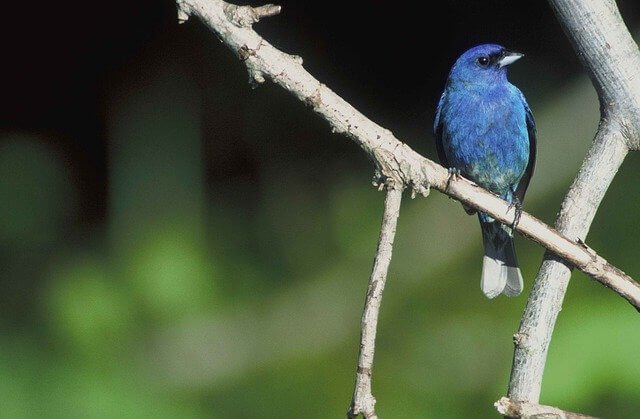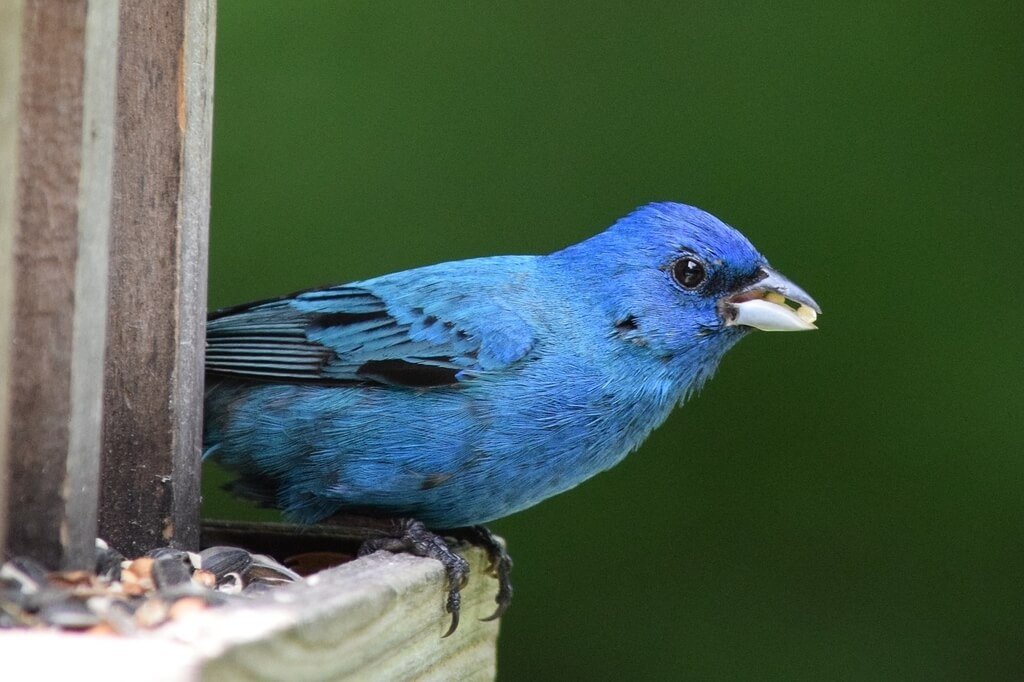
Indigo buntings are a beautiful blue bird that can be found throughout North America. They are shy birds and difficult to attract to your yard, but with some careful planning and execution, you can make it happen. Here are expert tips on how to attract indigo bunting to your yard.
Table of Contents
Identification
Indigo buntings are beautiful birds that get their name from the color of their body. Their bright blue plumage is complemented by a few black stripes on their wings. They have a shiny silver beak and are narrow and sharp.
- Length: 4.7-5.1 in (12-13 cm)
- Weight: 0.4-0.6 oz (12-18 g)
- Wingspan: 7.5-8.7 in (19-22 cm)
- Scientific Name: Passerina cyanea
- Sounds: Calls and Sounds
Distribution Range
The Indigo bunting’s distribution range includes much of the eastern half of the United States, as well as parts of Canada. Indigo Buntings are migratory, migrating between south Florida to northern Mexico. The birds fly in large flocks and can be seen near wetlands, lakes and other bodies of water during their migration.
Distribution Maps:
Habitat
The indigo bunting’s habitat consists of lowlands, wetlands, and near water. They like to forage for food in shallow areas such as marshes and wet fields.
Diet
The bird’s diet is largely dependent on the seeds and insects it finds in its habitat. In addition to nectar-feeding insects like ants, termites, wasps, bees, butterflies, dragonflies, grasshoppers, and grubs, the bird will also eat fruits, leaves and buds.
Although not omnivorous, it will eat plants that have seed inside it. Some researchers believe that it may even eat its own food.
Best Time to Spot Them
For instance, some Bunting’s may come out in the fall months and hang around for the winter months. During the spring and summer months, they will be more likely to come out in search of food.
When it comes to this particular breed of bird, it is vital that you feed them regularly. There is nothing better than having a hungry Indigo Bunting in your yard.
Picking a Spot for your Bird Feeder
The first tip on how to attract Indigo Bunting to your yard is to be sure to pick the right location for your garden. If you have a large backyard with a small space will do fine, but you should make sure that your feeder is not in the middle of the garden, where it will not get too much sunlight, or any type of wind.
The bird feeder should be located near a tree or other structure where you expect a lot of activity. You may have to do some research to find the best place for the feeder to attract bunting.
It’s best to find a location that has flowers close enough to the feeder to make them want to feed there. Also, make sure there is plenty of cover such as low-hanging branches, other feeders, bushes, or trees.
A perfect feeder for the indigo bunting is the Squirrel-proof Bird Feeder. I found the lowest price on Amazon.
Attracting to your Bird Feeder
One of the best ways on how to attract Indigo Buntings to your yard is through using bird feeders. These are specially made bird feeders that are designed for the birds.
The most important tip on attracting indigo bunting is to have a variety of feeders. Some birds enjoy feeding on the grass, while others prefer the seeds. Having different types of bluebird feeders in your backyard will help you find the ones that are best for them.
If you choose a feeder with a variety of food choices, you will be sure to find something that will attract a variety of birds. A great choice is this bird feeder with the Lyric Delite Bird Food for buntings. Check out the price on Amazon.
Plant Flowers, Shrubs and Trees
Another way of how to attract Indigo Bunting to your backyard is by using different types of flowers, shrubs or trees. Some of the more popular plants are the Blue-Gum, Grapevine Berry, Perennial Lily’s Breath, Rosemary, and Sunflower. These plants have very hardy seeds that will help them survive in your garden.
I found a method that will help you attract Indigo bunting to your feeder. This method involves making sure that your feeder contains an abundance of seeds, nectar, and pellets.

Pay Attention
As you can see, there is a lot you can do to attract Indigo to your yard. You just need to be aware of what is attracting them, what they like, and then take the time to find these birds that are native to your area.
Once you do this, you will notice that the birds are much easier to attract to your yard, and they will stay longer.
Keep a Well-maintained Yard
The second tip on how to attract Indigo to your yard is to make sure that your yard is well maintained. When you are trying to attract Indigo Bunting to your yard, it is also important that you keep the area clean.
Buntings often do not like too much dirt on their feet. It is also important that you have your yard properly mowed and kept up to code.
Put out a Bird Bath
Indigo, like other bunting are also drawn to bird baths and moving water. This means that the only way to draw the male bunting to your feeder is to get the bird bath in the exact direction where the male Bunting feeds. Then you can place a tall, thin branch or plant to catch his attention. I would recommend this very high-quality Alpine birdbath from Amazon.
Be Patient
There are many more tips on how to attract Indigo Bunting to my backyard, but these two are the basics. Just remember to be patient and you will see the results you are after.
Frequently Asked Questions
What type of seed do Indigo Buntings like?
The Indigo Bunting is a beautiful songbird with bright colors. It prefers to eat black oil sunflower seeds, safflower seeds, millet and thistle seed. In fact, it will refuse other types of food if given the chance.
Do Indigo Buntings nest in bird houses?
Indigo buntings don’t nest in birdhouses because they are cavity nesters and need hollows to make their nests. These birds also prefer shrubs or dense vegetation to hide their nests from predators such as hawks and cats, so it’s unlikely you’ll find them in birdhouses.
Which Bunting is the most colorful?
Painted Bunting is the most colorful of all bunting species. Painted Bunting, which can be found in Southern Florida and Central America, is known for its colors that are more vibrant than any other bunting.
Are Indigo Buntings rare?
Indigo Buntings are one of the most sought after birds for birdwatchers. They are rare, which makes them even more special. Indigo Buntings are uncommon to see in the wild. They migrate to North America for winter and can be found from Nova Scotia, Canada south through Mexico.
What does an Indigo Bunting symbolize?
The Eastern culture believes it to be a harbinger of Spring, as well as luck and good fortune. To many Native Americans, it’s considered to be sacred because they believe it helps their deceased ancestors find peace. In New England folklore, the bluebird was seen as both a protector against witchcraft and an omen for death.
Are Indigo Bunting monogamous?
Indigo Bunting are known to be socially monogamous, meaning they mate with only one partner and stay faithful to them for the duration of their relationship. This type of behavior can often be seen in other birds such as doves, robins, swifts, jays and blackbirds.


